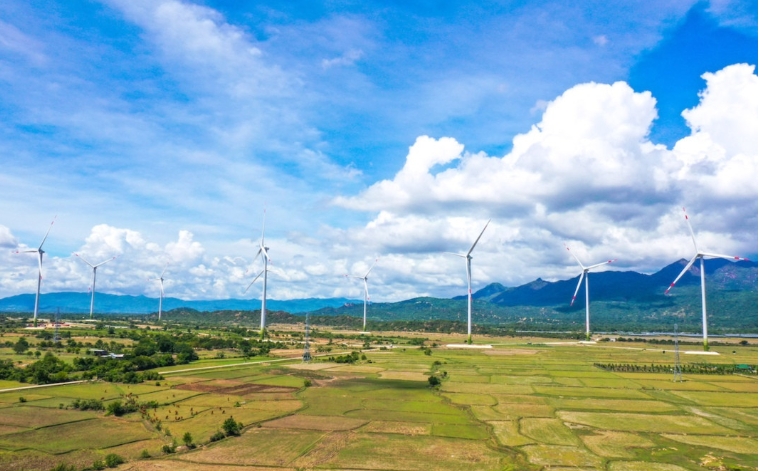Vietnam unlocks offshore wind power potential for green future
With 300,000 km² of sea and over 1,000 GW potential, Vietnam targets major offshore wind power (OSW) growth.

Under the national power development plan for 2021–2030 with a vision to 2050, the Party and State of Vietnam have set a target of installing 6–17 GW of offshore wind power (OSW) capacity between 2030 and 2035.
Several domestic and international organisations have already conducted preliminary studies on Vietnam’s offshore wind potential.
What the sector needs now is a powerful enough push to unlock a breakthrough in this environmentally friendly energy industry.
Immense potential
Numerous studies by Vietnamese and foreign scientists affirm that Vietnam has vast potential to develop offshore wind power. With a coastline of over 3,260 kilometers, a 12-nautical-mile territorial sea, and an exclusive economic zone (EEZ) stretching 200 nautical miles, the country enjoys consistently high and steady wind speeds - especially over the East Sea.
According to the National Centre for Hydro-Meteorological Forecasting under the Ministry of Agriculture and Environment, the Gulf of Tonkin and the Ninh Thuan–Vung Tau region have an average technical wind energy potential of around 500 W/m².
Preliminary research indicates that Vietnam's EEZ spans over 300,000 km² suitable for OSW development, with a potential technical capacity of more than 1,000 GW. Nearshore areas (within 6 nautical miles) offer around 58 GW in potential.
The World Bank has also studied Vietnam’s offshore wind capacity and identified 14 prospective zones for wind farm development. These could collectively produce 6 GW by 2030 and 40 GW by 2040 - figures aligned with national energy planning. The World Bank’s assessments also address suitable fixed-bottom technologies, levelized cost of energy (LCOE), biodiversity impacts, and socio-economic factors.
Dr. Du Van Toan of the Institute of Environment, Seas, and Islands under the Ministry of Agriculture and Environment noted that nations like those in Northern Europe, the US, and China have been developing offshore wind farms for decades. China alone now generates 40–50 GW from OSW - tens of gigawatts more than European nations and significantly ahead of the US.
Beyond contributing to Vietnam’s Net Zero goals, offshore wind power offers other advantages: it requires less land use, produces no noise pollution, and helps reduce strain on traditional power sources. Given the vast potential of Vietnam’s coastal areas, commercial use of OSW is entirely feasible.
While installation and operational challenges once hindered the technology, advances in science and engineering have significantly eased these constraints. Today’s offshore turbines - whether using horizontal or vertical axis designs - are highly efficient and durable.
However, their cost remains a major factor: each turbine can cost tens of millions of dollars. With a service life of around 35 years, investors are particularly concerned with long-term energy commitments and resource availability.
Challenges to overcome
According to Stuart Livesey, Country Director for Vietnam at Copenhagen Infrastructure Partners (CIP), offshore wind development has created around 300,000 construction jobs and 22,000 operational roles globally over the past 20 years.
Many of these workers have transitioned from oil, gas, thermal power, and mechanical sectors. Offshore wind operations also foster new professions in environmental science, project management, and electromechanics.
CIP has been instrumental in developing offshore wind in Taiwan and the Republic of Korea, combining wind power with supply chains, seaport infrastructure, and local economic development - demonstrating strong socio-economic benefits.
In Vietnam, renewable energy, particularly offshore wind, remained underdeveloped for years despite early research. This began to change with Resolution No. 36-NQ/TW (October 22, 2018) on sustainable marine economic development to 2030, with a vision to 2045.
Vietnam’s 2024 Electricity Law and the revised national power plan (Power Plan VIII) now allow for the development of up to 139 GW of OSW by 2050. At that scale, the projected value of the industry could reach approximately US$420 billion.
Still, most assessments of Vietnam’s OSW potential remain preliminary - based on long-term meteorological and hydrological monitoring, small-scale wind measurements, oceanographic and meteorological data, and a 12-month World Bank environmental survey.
These datasets provide a reasonably clear view of offshore wind’s potential and help determine electricity production costs, pricing schemes, investment risks, and suitable development zones. However, detailed geophysical and geotechnical surveys of Vietnam’s offshore areas are lacking. Key security, defence, and maritime safety evaluations are also still needed.
This underscores the significant groundwork required before offshore wind can become a major economic sector and a critical component of Vietnam’s Net Zero journey.
To achieve this, Vietnam must develop a clear and aggressive roadmap. Authorities need to define development zones, invest in advanced ocean monitoring systems, and thoroughly study offshore wind’s economic and market potential.
Efforts should also include exploring other marine energy sources (waves, tides) and establishing a mechanism for sharing meteorological-oceanographic data. These should all inform future national energy planning.
The global shift from traditional to green energy is accelerating. Offshore wind’s economic, environmental, and energy security benefits can significantly boost Vietnam’s development and support its COP26 commitment to net-zero emissions by 2050.



